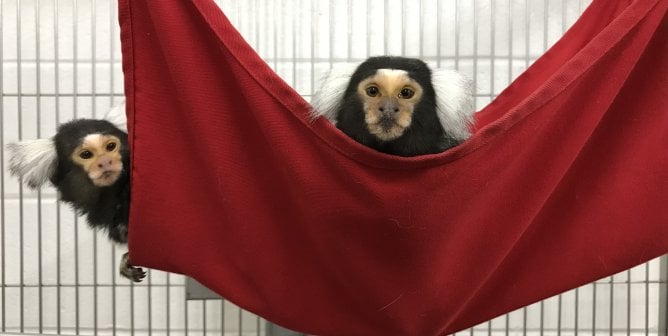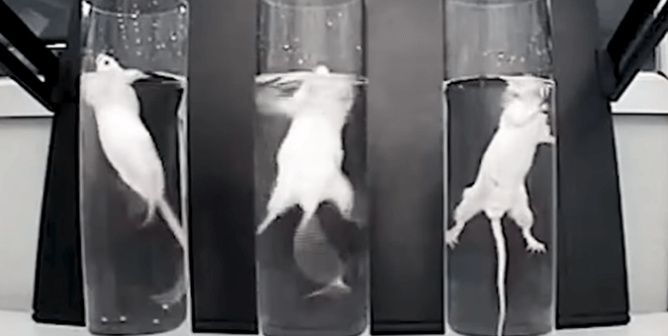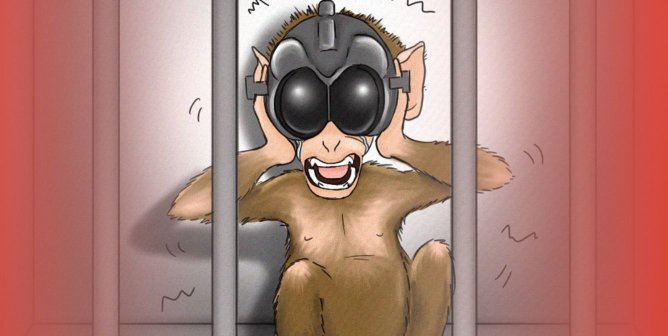Dissection: Lessons in Cruelty
Every year, millions of animals are dissected in elementary and secondary science classes. Each animal who is cut open and discarded represents not only a life lost but also a part of a trail of animal abuse and environmental havoc.
Suppliers
Frogs are the most commonly dissected animals below the university level. Other species used include cats, mice, rats, worms, dogs, rabbits, fetal pigs, and fish. Some animals come from breeding facilities that cater to institutions and businesses that use animals in experiments, and other animals are caught in the wild. Some animals are also stolen or abandoned companion animals. A PETA undercover investigator at one of the nation’s largest suppliers of animals used for dissection was told by his supervisor that some of the cats killed there were companion animals who had “escaped” from their homes. Slaughterhouses and pet stores also sell animals and animal parts to biological supply houses. Even some pounds and animal shelters sell animals to biological supply companies, which in turn sell them to schools.
PETA investigators documented cases in which animals were removed from gas chambers and injected with formaldehyde without first being checked for vital signs, a violation of the Animal Welfare Act. Formaldehyde is a severely irritating caustic substance that causes a painful death. Investigators’ video footage documents incidences in which cats and rats were struggling during injection and employees were spitting on them. One rabbit, still alive after being gassed, tried to crawl out of a wheelbarrow full of water and dead rabbits. Employees laughed as a coworker held the rabbit’s head underwater and pulled him out just as death seemed near, repeating the process again and again until, bored with the “game,” the employee held the animal’s head underwater long enough to drown him.
Killing Compassion and Love for Science
Classroom dissection desensitizes students to the sanctity of life. Research has shown that a significant number of students at every educational level are uncomfortable with the use of animals in dissection and experimentation. Studies also suggest that exposing young people to animal dissection as “science” can foster a callousness toward animals and nature and even dissuade some from pursuing careers in science.1,2,3
Students don’t need to cut up animals to understand basic anatomy and physiology. Those who plan to go into a medical field would do better to study humans in a controlled and supervised setting, examine human cadavers, or use any of the many non-animal teaching methods available, such as those provided by computer models and sophisticated simulators. This type of simulation-based education would more accurately reflect what students will encounter when they get to medical school, since all U.S. medical schools have abandoned the use of animals in their standard curricula.4 Read more about Alternatives to Dissection.
Students Speak Up
Many students are taking a stand against dissection before it happens in their classes.
“You don’t learn anything about an animal by cutting it up,” said Laurie Wolff, a Las Vegas grade school student who successfully petitioned the Clark County School Board to draft a student-choice amendment, providing students with alternatives to dissection. “It’s a waste when there are so many other ways to learn about science without having to kill something first,” she added.5 Baltimore student Jennifer Watson, who was taken out of an honors class when she asked for an alternative to cat dissection but was allowed back in after a protest prompted officials to reveal that she was entitled to an alternative, explained her actions simply: “I’ve loved animals my whole life. I was standing up for what I believe in.”6 Ashley Curtis failed a lab exercise in her Minnesota school when she refused to come to class on the day when dissection was scheduled. She said, “I don’t think any animals should go through any suffering for education.”7
More than a dozen states, including Virginia and California, along with numerous school districts, have enacted laws or policies protecting students’ right not to dissect.8
Non-Animal Teaching Methods
Nearly every comparative study has concluded that non-animal teaching methods, including virtual dissection software, are equivalent or, in many cases, superior to traditional animal dissection in their ability to provide students with an understanding of anatomy and complex biological processes.9,10
The typical science lab at many schools now emphasizes computer simulations, interactive CD-ROMs, films, charts, and lifelike models rather than animal cadavers. Students and teachers can choose from a wide range of sophisticated alternatives to dissection, including the following:
- The Digital Frog is a fully interactive CD-ROM that allows students to explore the frog through three seamlessly linked modules—dissection, anatomy, and ecology.
- Anatomy in Clay allows students to build the body systems of humans and animals out of clay on model skeletons.
- DissectionWorks comprises five interactive, computer-dissection simulations, including those of a frog, crayfish, perch, and fetal pig. A digital cat dissection with detailed graphics and information is also available.
- Body Works offers a fascinating computer program that explores the body’s systems, structure, and functions.
- Sniffy the Virtual Rat is a unique computer program that allows students to explore the principles of operant psychology using a “virtual rat.”
- Great American Bullfrog is a large-scale model with numbered parts and a key card; circulatory, reproductive, and other systems can be separately dissected.
- Biology Chart Series includes detailed charts of a dissected frog, perch, crayfish, grasshopper, earthworm, etc.
Many books also offer humane science lessons. The Anatomy Coloring Book, The Zoology Coloring Book, and From Guinea Pig to Computer Mouse: Alternative Methods for a Progressive, Humane Education are appropriate for high school and college students.
Most non-animal tools and lessons last for many years and cost less than maintaining a constant supply of animals. Because computer methods allow students to learn at their own pace, they have proved to be as good as, and often superior to, dissection as a teaching tool. One university professor who compared students using an interactive “frog” computer program with those cutting up real frogs found that students using the virtual program learned anatomy just as thoroughly—in an environment that didn’t reek of formaldehyde or require the killing of a living being.11 Even the vice president of one of the country’s largest animal supply companies conceded, “Dissection is no longer cutting edge.”12
A comprehensive list of alternatives to dissection is available from the Physicians Committee for Responsible Medicine’s “Dissection Alternatives” Web site. You might also want to contact the Ethical Science & Education Coalition , which offers “Beyond Dissection: Innovative Tools for Biology Education,” a comprehensive catalog with information on hundreds of humane alternatives to dissection.
What You Can Do
Whether you are a student, a parent, or a concerned taxpayer, you can act to end dissection in your town’s school system. If you are expected to perform or observe a dissection, talk to your teacher as early as possible about alternative projects.
Contact PETA for a free “Cut Out Dissection” pack and for tips on what to say and how to proceed. If there is an animal rights group at your school or in your community, ask the group to help. Parents can urge their local Parent-Teacher Association to ask the superintendent of schools or the school board to consider a proposal to ban dissections in public schools or at least give all students the option of doing a non-animal project. It might help to collect signatures on a petition and present the school board with information on the cruelty and environmental destruction caused by animal dissection. Be sure to provide readily available alternatives.
References
1Arnold Arluke and Frederic Hafferty, “From Apprehension to Fascination With ‘Dog Lab’: The Use of Absolutions by Medical Students,” Journal of Contemporary Ethnography 25.2 (1996): 201-25.
2Dorian Solot and Arnold Arluke, “Learning the Scientist’s Role: Animal Dissection in Middle School,” Journal of Contemporary Ethnography 26.1 (1997): 28-54.
3Martin Stanisstreet, Nina Spofforth, and Trefor Williams, “Attitudes of Undergraduate Students to the Uses of Animals,” Studies in Higher Education 18.2 (1993): 177-96.
4Darryl Fears , “One Last U.S. Medical School Still Killed Animals To Teach Surgery. But No More,” The Washington Post 30 Jun. 2016.
5Emily Richmond, “School Board Approves Dissection Waivers,” Las Vegas Sun 12 Apr. 2002.
6David Crary, “Students Refuse to Dissect Animals,” Associated Press, 1 Oct. 2002.
7“Of Mice and Frogs: Dissection Questioned,” Star Tribune 21 Jan. 2004.
8P.J. Dickersheid, “Students Skip Slime, Stink With Virtual Dissection,” Associated Press, 1 Jun. 2008.
9G.J. Patronek and A. Rauch, “Systematic Review of Comparative Studies Examining Alternatives to the Harmful Use of Animals in Biomedical Education,” Journal of the American Veterinary Medical Association 230.1 (2007): 37-43.
10Andrew Knight, “The Effectiveness of Humane Teaching Methods in Veterinary Education,” AATEX 24.2 (2007): 91-109.
11Beverly Orndorff, “Computer Program Is a Frog Saver,” Richmond Times-Dispatch 5 Apr. 1994.
12Suzanne Sataline, “Cutting Edge Biology in Many Schools, Dissections Are Giving Way to Computer Simulations,” The Boston Globe 31 Dec. 2003.







